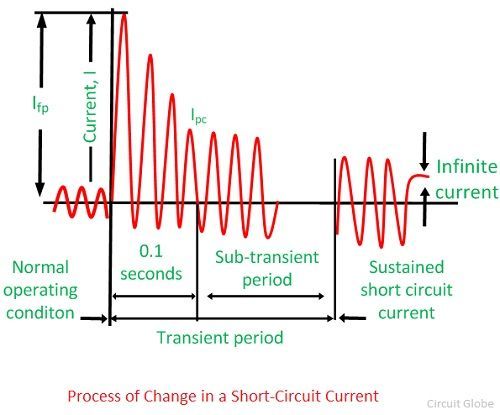When two or more conductors of different phases come in contact with each other in a power line, power transformer or any other power element, then the part of the impedance is shunted out of the circuit due to which a large current flow in the un-faulted phases, such current is called the short circuit current. Short circuit current reduces the effect of impedance in the circuit while the current in the circuit rises.
Short-circuit current is harmful for two reasons
- The flow of large current will overheat the equipment.
- The flow of short circuit current in the current carrying parts produces a force of electrodynamics interaction which may destroy or damage the equipment.
Whenever a short-circuit occurs in a power network, it causes a heavy current to flow in the circuit. The magnitude of short circuit current is shown in the graph below. During the first moment of the fault current, the current attains to its maximum value and then decreases to its steady state value.
 During the fault, the current undergoes a continuous change and the phenomenon observed is called the transient phenomenon. The word transient refers to a temporary happening which lasts for a short duration of time. The zone in which current is very high but falls very rapidly is called the sub-transient current.
During the fault, the current undergoes a continuous change and the phenomenon observed is called the transient phenomenon. The word transient refers to a temporary happening which lasts for a short duration of time. The zone in which current is very high but falls very rapidly is called the sub-transient current.
Sustained current is the fault current that will flow in the circuit if it is allowed to persist after the transient process end. Ifp is the first peak short circuit current. It is the maximum instantaneous value of the current that will reach during the first moment of a short circuit current. Ipc is the rms value of the periodic component of the short-circuited current. During the steady state, the rms value of the short-circuit current remains almost constant.
